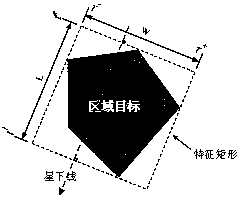Decomposition and Synthesis Method of Imaging Satellite Observation Tasks Based on Time-Attitude
An imaging satellite and task decomposition technology, applied in the direction of integrated navigator, etc., can solve the problem of no concept of time, only consider the space position, etc., and achieve the effect of intuitive and efficient target decomposition and synthesis
- Summary
- Abstract
- Description
- Claims
- Application Information
AI Technical Summary
Problems solved by technology
Method used
Image
Examples
Embodiment Construction
[0045] The present invention will be further described below by specific examples.
[0046] Time-attitude vector of 1-point target
[0047] The latitude and longitude heights of the point target (Target) in the WGS84 coordinate system are b, l, and h respectively, and the position of the satellite at time t in the J2000 geocentric inertial coordinate system is The pointing attitude of the satellite to the target at time t in the orbital coordinate system is When calculating the positional relationship between the satellite and the target, they can be transformed into a coordinate system.
[0048] For a satellite flying normally, the position of the satellite is a function of time, and the position of the satellite at a certain time in the future can be predicted by using the high-precision ephemeris prediction method, that is, the position of the satellite corresponds to the time point one by one:
[0049]
[0050] The position of the target can be converted to the posi...
PUM
 Login to View More
Login to View More Abstract
Description
Claims
Application Information
 Login to View More
Login to View More - R&D Engineer
- R&D Manager
- IP Professional
- Industry Leading Data Capabilities
- Powerful AI technology
- Patent DNA Extraction
Browse by: Latest US Patents, China's latest patents, Technical Efficacy Thesaurus, Application Domain, Technology Topic, Popular Technical Reports.
© 2024 PatSnap. All rights reserved.Legal|Privacy policy|Modern Slavery Act Transparency Statement|Sitemap|About US| Contact US: help@patsnap.com










